|
Spidermites – Plague of the Summer Garden
We received this question via my website, PLANTanswers.com in mid-June:
Sent: Tuesday, June 10, 2014 5:36 AM
To: Plant Answers: Ask the Answer Man
City or Zip Code: 78261
Subject: spots/specks on tomato plant leaves
Question:
My tomato plant leaves are covered with small specks. The leaves are starting to turn lighter toward yellow.
What can it be and how can it be controlled? Have gotten lots of blooms and have dozen tomatoes various sizes.
Any advice would be helpful.
This is one of the best descriptions of symptomatic damage of a beginning population of one of the most destructive hot-season pests we have on garden plants --- especially tomatoes. The most prolific, elusive insects (which are really spiders) of any garden are the spider mites. These girls coined the phrase strength in numbers and they are committed to the cause! When conditions are optimum (hot and dry), they can double their population in 4 days. Don't feel sorry for the requirements placed on the male in order to accomplish this feat - - their services are not required, but once. Isn't that sick?! These gals have taken woman's liberation too far; they only visit their male counterpart once during a lifetime. What's worse is that some ladies eat the male after the encounter - - that's gratitude for you!
Even though mites are small, their huge populations are mighty when potential plant damage is considered. These mighty small spider mites are often unnoticed by gardeners until the plant has been severely damaged. That is why it is very important to notice the subtle changes such as plant leaves being covered with small specks and the leaves are starting to turn lighter toward yellow becoming dull in appearance. Spider mites flourish in hot, dry conditions. They are named for the webs they make on their host plants while feeding. Spider mites usually feed on the green chlorophyll on the undersides of leaves and cause a stippled bronze coloration dotted with yellow specks on the surface of the leaf. Tiny webbing is usually present on the underside of leaves as the population increases to several million individuals!
Gardeners respond by using carbaryl (Sevin) or other insecticides. This often eliminates beneficial insects which consume spider mites. The predator elimination allows the mite populations to multiply rapidly. The mite is not an insect but rather related to spiders. They can NOT be controlled but rather the host plant should be eliminated or their population-explosion be slowed by the use of seaweed extract. There are several good organic controls for spider mites. Seaweed spray THOROUGHLY applied twice per week does the job. The new product Spinosad (Conserve and other product names) also seems to work. Add one teaspoon of a liquid soap per gallon of pesticide spray to insure good wetting of foliage and try to spray the bottoms of leaves as much as possible. Since mite eggs hatch ever 3-5 days and since sprays kill only the adults, consecutive sprays will hopefully destroy the young before they reach puberty.
NOTHING works when populations are dense and weather is hot and dry. The best control is destruction of infested plant materials when identified---DEFINITELY eliminate ALL infested plants before planting a fall garden.
That is my recommendations---here are some answers to other questions about spidermites:
Question: I have a raised bed garden and have battled spider mites to no avail. They have ruined my tomatoes. I use cypress mulch in my garden as well as a weed block. Do I need to get rid of these things to start the garden this year? Please help I want my garden back.
Answer: Spider mites do over winter in mulches and plant debris left over from the previous summer. But if you think that you will avoid mites by burning, scorching, "poisoning", or otherwise sterilizing your garden soil, you are mistaken. Spider mites have an admirable capacity to find tomatoes even if the tomatoes are planted on virgin soil. They apparently do this via wind transport, or some other means we haven't quite figured out.
Unfortunately, there are not many magic bullets on the market for spider mite control on vegetables. I recommend an integrated approach.
(1) Do not compost mite infested plant material (There's no use giving mites a head start. Unless your compost pile is uniformly hot enough to kill mites, I'm convinced this is another way mites can infest a garden.)
(2) Inspect your tomato seedlings for mites and choose only mite free plants (Again, let's not help the mites by giving them an early start). With a hand lens, check the undersides of a few leaves of every plant you purchase.
(3) At the first sign of infestation (assuming you do check your plants a couple of times a week for the first signs of spider mites on leaf undersides), do one of the following: try blasting mites off with a stiff stream of water directed at leaf undersides (this can significantly delay mite population buildups, if done thoroughly); apply horticultural oil or insecticide soap sprays; pick off and destroy any leaflets you find mites on.
(4) Get your spring tomatoes started early, and remove plants when they become mite infested. Instead of battling the mites, give in and focus on a late summer planting of tomatoes. Sometimes the fall tomato crop is easier to grow without spider mites.
Michael Merchant, PhD, BCE; Urban Entomologist; Texas A&M AgriLife Extension Service in Dallas, Texas
From Dr. Calvin Finch writes:
Spider mites become a real problem on tomatoes when the weather becomes hot. The generation time of the tiny sucking insects becomes as short as four or five days. Spider mites feeding cause the leaves to have a dusty faded look. In severe infestations, tiny webs cover the plant. There are several good organic controls for spider mites. Seaweed spray THOROUGHLY applied twice per week does the job IF STARTED early in the growing season and used as a preventive BEFORE mite populations explode. The new product Spinosad (Conserve and other product names) also seems to work. Neem oil is labeled for spider mites, but I have not found it very effective.
To determine if you have spider mites, flick a leaf with your forefinger over a white piece of paper. You should be able to see the red pinhead size mites moving on the paper.
SPIDERMITES
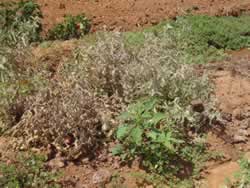
Notice the green careless weed in front and purslane in
the back of this heavily infested tomato plant. The weeds
will be attacked later |
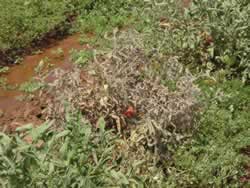
Spidermites randomly infest plants then spread to adjoining
plants as their populations increase
|

Notice the yellowing plants at the far right corner of
this garden. Spidermites begin in pockets and spread across
the entire garden spread by wind. |
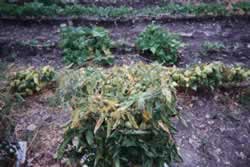
Spidermite infestations can occur in the top portions
of the plant. Notice the damaged bush snapbeans in the
immediate background. |
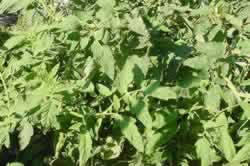
Notice the healthy tomato foliage as compared to the light-green
to yellow foliage of an infested plant |
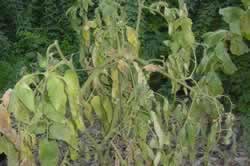
A heavily infested by spidermites plant with yellowing
and drying foliage |
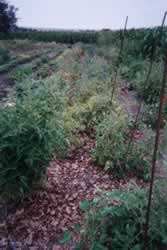
Notice the yellowing, heavily-infested tomato plants which
have started to yellow |

Spidermites are the main culprit of the garden favorite,
sweetpeas |

Spidermites suck the green chlorophyll from foliage leaving
damaged plants a lighter-green |
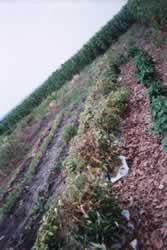
The best cultural techniques cannot stop a spidermite
invasion |
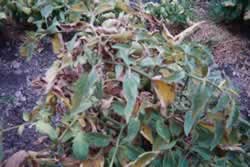
The foliage of spidermite-damaged plants go from light
green to yellow to dead brown. damaged |
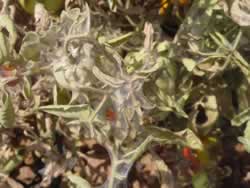
The tiny specks in the webbing around this tomato cluster
are thousands of tiny spidermites |
| |

Large mature red mites with millions of immature mites feeding on bottom of leaf |
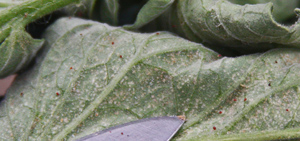
LARGE red adult spidermites |
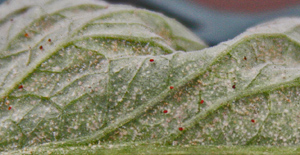
Red specks are spidermites; brown specks are their young |

Clusters of mites on ribs of foliage |
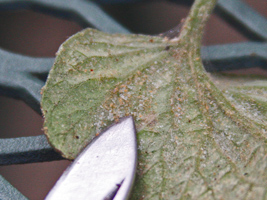
Millions of mites near the blade of a knife; notice webbing on the stem of the leaf |
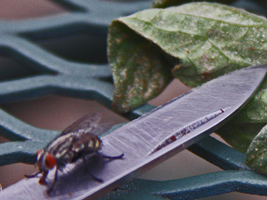
Thousands of mites can fit on the wing of a fly! |
| |
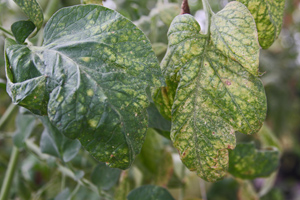
|
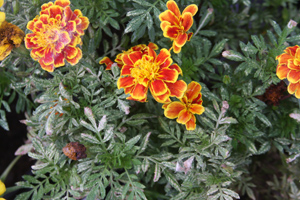
|
| |
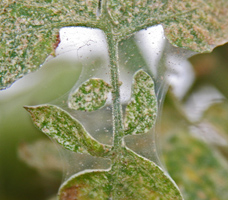
|
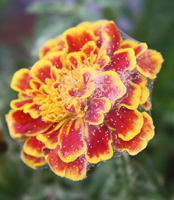
|
|
|
|



